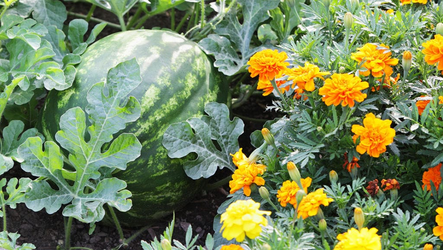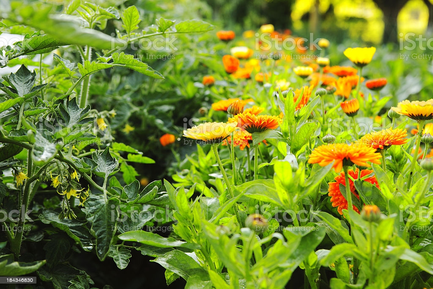 Marigolds benefit watermelons by repelling beetles.
Marigolds benefit watermelons by repelling beetles.
Jessica Walliser, a horticulturist and author of Plant Partners: Science-Based Companion Planting Strategies for the Vegetable Garden, wanted to research which companion plants would reduce pests and improve pollination. She wasn’t satisfied with anecdotal recommendations, so she researched scientific literature to find out for herself which plants were the best companions and why.
Most of the literature she found was aimed at large-scale farms rather than small-scale gardens, which was the kind of growing Walliser was used to. Nevertheless, it was still an improvement over the folklore she had heard, so she dug in.
The one idea she discovered in her research that unites all others is this: Diversity in your garden always helps the plants, and monoculture always harms them. Companion planting can attract beneficial insects, which reduces the need for pesticides and other chemicals that can harm the environment. But companion planting can also reduce weeds and improve the soil as well. Cover crops are one example of this. They can act as living mulch, limiting weeds by crowding out any weeds that might try to grow. And certain cover crops like rye and oats contain natural weed- suppressing chemicals, which can prevent weeds from growing in your garden after you till the garden to make room for your regular crops.
 Calendulas benefiting tomatoes in the garden.
Calendulas benefiting tomatoes in the garden.
Certain plants can also act as a decoy to protect your crops. For example, radishes planted among young tomatoes can distract flea beetles from the tomatoes, and draw them to the radishes instead. If you’re trying to distract a species whose adults are mobile, such as potato beetles, squash bugs, cabbage butterflies, etc., then it’s best to plant the decoy plants on the perimeter of your garden, several feet away from the crops you’re trying to protect. But if you’re protecting against a pest with more limited mobility, like aphids, flea beetles, etc., then you can plant the decoy very close to the actual crop, in alternate rows with the crop.
Of course, even with companion planting to deter pests, gardeners are almost certain to get some kind of pests on their crops at some point. Walliser recommends we develop a realistic tolerance to some amount of pests. She also suggests we remove any diseased or faded leaves as they appear, and that we combine companion planting with smart mechanical controls, like putting row covers on vulnerable crops to protect the plants against flying insect pests, or scraping pest eggs off leaves and letting them fall onto sticky tape to trap them. And finally, she warned, please allow enough space for each plant to grow. Companion plants may work well close to each other, but if you put them too close, then they will compete for water and nutrients.
I hope this blog is helpful to you for starting a companion planting garden of your own. If you do grow your own, we would love to hear how it turns out!
- Chris Tidmarsh
 RSS Feed
RSS Feed
